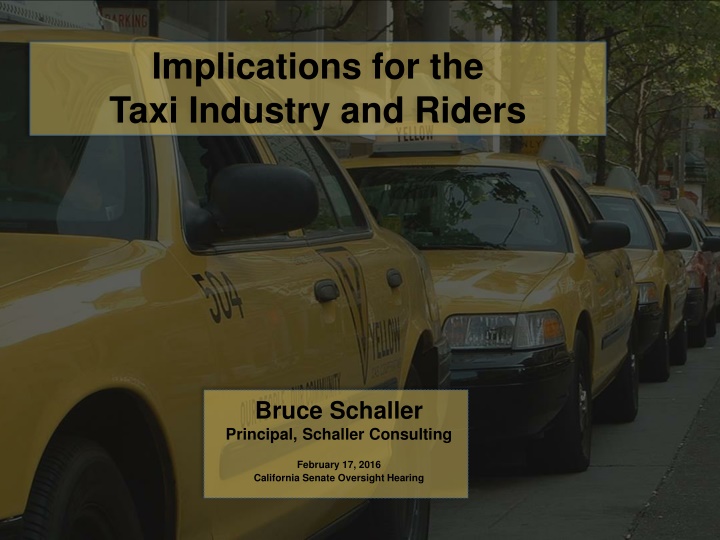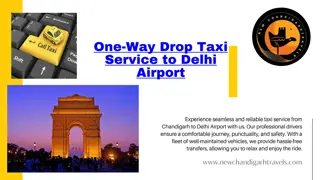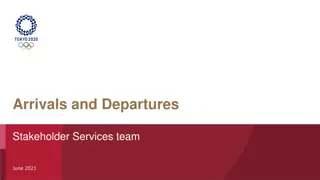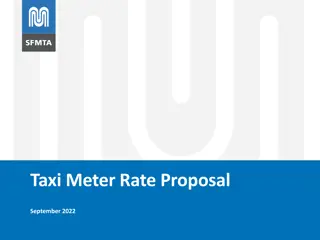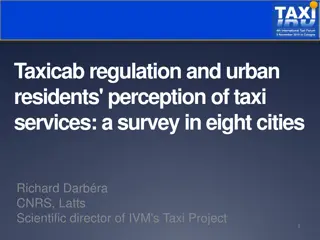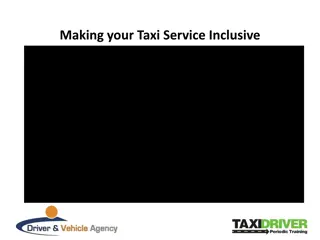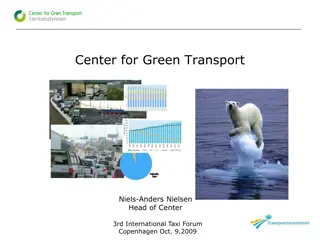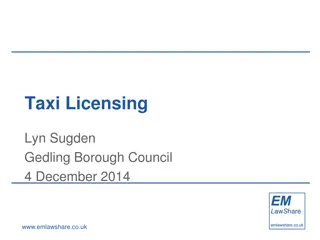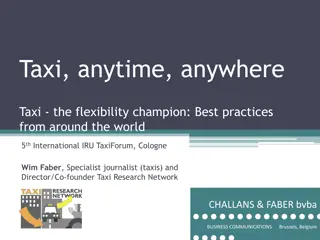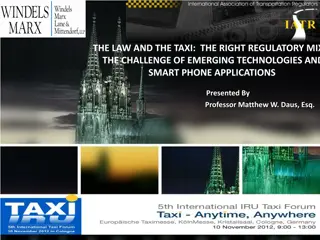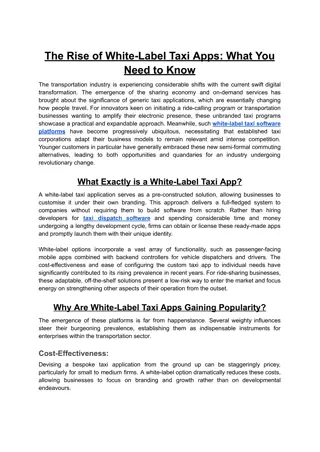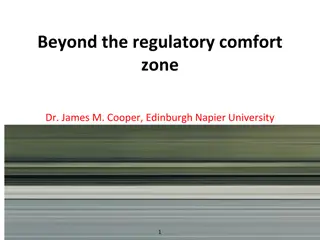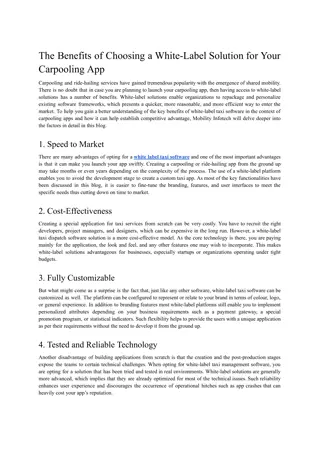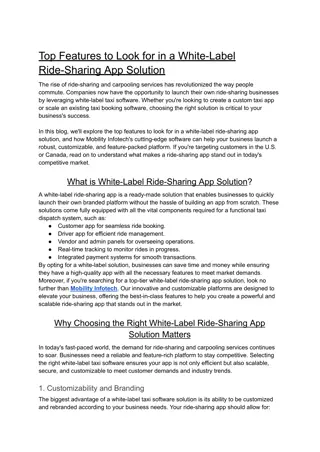The Changing Landscape of the Taxi Industry: Implications and Responses
The taxi industry is facing significant challenges with the rise of ride-sharing services like Uber and Lyft. This shift has led to declines in trips and revenues for traditional taxis in cities like San Francisco, Los Angeles, and New York. There are two main viewpoints on this issue: one advocating for regulatory changes to level the playing field, while the other embraces the competition and calls for innovative solutions within the taxi industry. Both sides have different perspectives on regulatory measures and responses to the changing market dynamics.
Download Presentation

Please find below an Image/Link to download the presentation.
The content on the website is provided AS IS for your information and personal use only. It may not be sold, licensed, or shared on other websites without obtaining consent from the author.If you encounter any issues during the download, it is possible that the publisher has removed the file from their server.
You are allowed to download the files provided on this website for personal or commercial use, subject to the condition that they are used lawfully. All files are the property of their respective owners.
The content on the website is provided AS IS for your information and personal use only. It may not be sold, licensed, or shared on other websites without obtaining consent from the author.
E N D
Presentation Transcript
Implications for the Taxi Industry and Riders Bruce Schaller Principal, Schaller Consulting February 17, 2016 California Senate Oversight Hearing
Ride Service Market is Expanding 42% increase in taxi & limo industry revenue from 2002 to 2012 (in billions, adjusted for inflation) 16.0 14.1 14.0 12.4 12.0 9.9 10.0 8.1 8.0 6.0 4.0 2.0 - 1997 2002 2007 2012
Ride Service Market is Expanding 32% increase in working taxi drivers & chauffeurs from 2000 to 2006-10 (5-year average) 350,000 302,960 300,000 250,000 230,222 194,302 200,000 175,411 152,162 150,000 100,000 50,000 - 1970 1980 1990 2000 2006-10
Whats Happening with Taxicabs? Declines in trips and revenues: San Francisco 20-30% Los Angeles 24% New York City 19% Boston 35% Seattle 28% St. Louis up to 40%
Whats Happening with Taxicabs? Declines in trips and revenues: COMPETITION Uber Lyft San Francisco 20-30% Los Angeles 24% New York City 19% Boston 35% Seattle 28% St. Louis up to 40%
Two Schools of Thought TNCs, many customers, commentators and elected officials Taxi industry, regulators It s the It s unfair competition! American way! Lower standards for criminal record checks and auto insurance Wider choice of vehicles Surge pricing Uncontrolled entry No requirements for geographic coverage, wheelchair-accessibility Better service Technological innovation Pricing matches supply and demand Promotes urban lifestyles Reduce DUI
What Should be Done? TNCs, many customers, commentators and elected officials Taxi industry, regulators Regulatory response: TNCs need different regulatory model that fits their different business model Cease-and-desist orders Apply taxi regulations to TNCs Ask for regulatory relief Competitive response: Taxi apps Friendlier drivers and better- kept vehicles
TRB Report 319 calls for Encourage and facilitate innovations that meet mobility needs Ensure fair competition between taxis and TNCs
Unlevel Playing Field Taxis TNCs Fleet size Set by regulation Set by TNC Price Set by regulation Set by TNC Geog. controls Limited to city/zones None; operate statewide Taxi stands Authorized to pick up Limited to dispatch trips Gov tbackground checks Driver safety TNC background checks Vehicle safety Gov t standards/inspections TNC standards/gov t inspec. Veh. insurance Commercial, 24/7 Varies by period Service quality Mix of gov t standards and customer choice Customer choice
Recommendations for Fair Competition Issue Recommendation Entry controls Pricing Examine minimum regulation necessary (greater for hail/stand trips) Be consistent across each type of service (taxi stand, dispatch) Systematic evaluation, gauged to risk Driver background checks Insurance requirements Wheelchair-accessible service Ensure access through regulation, incentives, mandates and/or subsidies Apply across each type of service Regulatory authority Balance benefits uniformity and responsiveness to local needs Ensure on-the-ground regulatory enforcement
Implications for Regulation Match scope of regulation to level of competition and user choice: Dispatch operations Street hail/taxi stand trips Airport-originating trips Control entry and fares only for hail/stand part of the service Set background check and insurance requirements using risk- based analysis focused on outcomes Find innovative ways to serve higher-cost trips (addressing wheelchair accessibility and digital divide) Ensure consistency and coordination between taxi and TNC regulation Vision where everyone could be both driver and passenger
Goals of Regulatory Framework Flexibility: Compete on service quality Compete on selection Compete on price Openness: New services New service providers Accountability: Government Consumers Prevent abuses Monopoly power, predatory pricing, deceptive practices, illegal practices to distort how the market works Serve goals of mobility, economic efficiency and equity
